In the realm of landscaping, synthetic turf has emerged as a game-changer. This innovative solution, often referred to as synthetic grass, artificial turf, or turf synthetic, promises the beauty of a lush, green lawn without the demanding upkeep. From residential gardens to sprawling sports arenas, the appeal of a maintenance-free, always-green space has made synthetic turf a sought-after choice. In this comprehensive guide, we’ll delve deep into everything you need to know about this landscaping marvel.
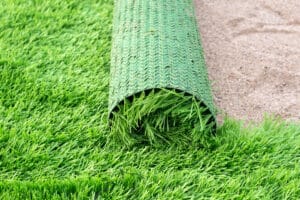
History of Synthetic Turf
The inception of synthetic grass can be traced back to the 1960s. Initially conceptualized for sports arenas that sought a low-maintenance alternative to natural grass, its popularity skyrocketed. Over the decades, with technological advancements, artificial turf has evolved, becoming almost indistinguishable from natural grass in both appearance and texture. Today, whether it’s for a backyard playground or a professional football field, synthetic turf stands as a testament to human ingenuity, bridging the gap between nature’s beauty and human convenience.
Benefits of Synthetic Turf
Low Maintenance: One of the primary attractions of an artificial grass lawn is the minimal upkeep it demands. Forget about mowing during the weekends, watering during dry spells, or battling with pests. Your lawn remains pristine, come rain or shine.
Cost-Effective: While the initial investment for synthetic grass might seem steep, it’s a long-term saving venture. Consider the expenses you’ll cut down on: water bills, fertilizers, lawn maintenance equipment, and more. Over time, these savings add up, making synthetic turf a financially sound choice.
Environmentally Friendly: In an age where environmental conservation is paramount, synthetic turf offers a green solution. There’s no need for pesticides, herbicides, or frequent watering. This not only conserves water but also reduces the chemical runoff into our ecosystems.
Aesthetic Appeal: With advancements in design and technology, modern synthetic turf is a visual delight. It mimics the look and feel of natural grass so closely that distinguishing between the two can be challenging. Whether it’s the peak of summer or the dead of winter, your lawn remains a vibrant green oasis.
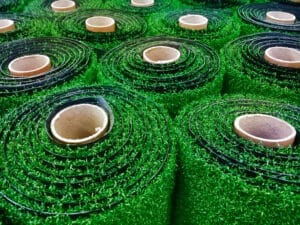
Types of Synthetic Turf
Diving into the world of synthetic grass, you’ll encounter a variety of options tailored for different needs. From the materials used to specific designs for varied applications, understanding these can help you make an informed decision.
Materials: Polyethylene, polypropylene, and nylon are the primary materials used in manufacturing. Each offers a unique texture and durability level, with polyethylene being the most popular for its soft, natural feel.
By Use: Whether you’re looking for turf for sports, residential, or commercial purposes, there’s a type designed specifically for it. Sports turfs, for instance, are crafted to withstand high foot traffic and rigorous activity. In contrast, residential turfs prioritize aesthetics and comfort.
Synthetic Grass vs. Natural Grass
The debate between synthetic grass and its natural counterpart is age-old. While natural grass has its charm, the benefits of synthetic grass are hard to overlook.
Maintenance: Natural grass requires regular mowing, watering, and fertilizing. In contrast, synthetic grass demands minimal attention once installed.
Cost: Though synthetic grass has a higher initial cost, its low maintenance nature makes it cost-effective in the long run.
Environmental Impact: Natural lawns, especially in dry areas, consume vast amounts of water. Synthetic lawns eliminate this need, playing a crucial role in water conservation.
Appearance: While natural lawns can brown and wither, synthetic lawns maintain their lush green appearance year-round
Key Components of Synthetic Grass
Understanding the anatomy of synthetic turf can greatly influence your purchasing decision. Here’s a breakdown of its essential components:
Pile Height: This refers to the length of the grass blades. A longer pile height might seem more luxurious, but it can also lead to the blades drooping over time. For a natural look, many homeowners opt for a pile height between 30-37mm.
Infill: Acting as the ‘soil’ for your artificial grass, the infill provides stability, cushioning, and weight. There are various types, including sand, rubber, and a combination of both. The choice of infill can affect the feel underfoot, drainage, and overall longevity of the turf.
Backing Material: This is the layer to which the synthetic grass blades are sewn. Quality backing ensures your turf remains robust and durable, resisting wear and tear. It’s often made of polyurethane or latex, with perforations for drainage.
Installation Process
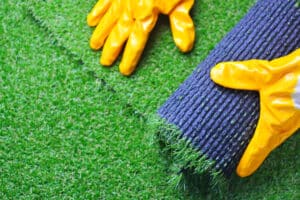
Installing synthetic grass might seem daunting, but with the right steps, it’s a smooth process:
Ground Preparation: Begin by removing the existing lawn and a few inches of the topsoil. This creates a clean slate. Next, a layer of crushed stone is spread and compacted to ensure proper drainage.
Laying the Turf: Roll out the synthetic turf over the prepared area. It’s essential to ensure there are no wrinkles or bubbles. Adjacent pieces should be seamed together seamlessly.
Securing and Finishing: Once laid out, the turf is secured using specialized U-shaped nails. The infill is then spread across the turf and brushed in using a stiff-bristled broom. This gives the turf a plush, natural appearance.
Maintenance and Care
Contrary to popular belief, synthetic grass isn’t entirely maintenance-free. However, the upkeep is minimal compared to natural grass:
Cleaning: A simple rinse with water can remove dust and small debris. For larger debris like leaves, a plastic rake or leaf blower works wonders.
Sanitizing: If you have pets, it’s advisable to sanitize the area occasionally to prevent odors and bacteria buildup.
Brushing: Over time, high traffic can cause the blades to flatten. A gentle brushing can rejuvenate the turf, making it stand upright.
Common Myths and Misconceptions
Myth 1: “Synthetic turf looks blatantly fake.” Modern artificial grass is designed to mimic natural grass closely. With advancements in technology, it’s often hard to distinguish between the two.
Myth 2: “It’s too hot to walk on during summers.” While synthetic turf can get warmer than natural grass, choosing lighter colors and installing it in shaded areas can mitigate this.
Myth 3: “It’s not pet-friendly.” On the contrary, many synthetic turfs are designed specifically with pets in mind. They’re easy to clean and resistant to the wear and tear of playful paws.
Synthetic Turf for Sports
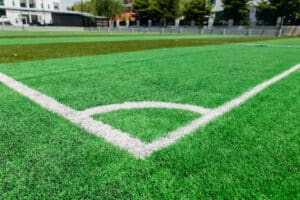
From football fields to tennis courts, synthetic turf has revolutionized the sports industry. Its uniformity ensures a level playing field, literally and figuratively. Moreover, it’s durable enough to withstand rigorous sports activities, making it a favorite for many sports organizations.
Residential Uses
Imagine a backyard that remains green throughout the year, irrespective of the weather. That’s the beauty of an artificial grass backyard. Beyond aesthetics, it’s also a practical choice for play areas, ensuring kids can have fun without the mud and mess. Moreover, for pet owners, synthetic turf can be a boon, ensuring a clean space for pets to play.
Commercial Uses
For businesses, first impressions matter. A lush green lawn can enhance the aesthetic appeal of commercial spaces, be it office complexes, malls, or restaurants. Moreover, the low maintenance nature of synthetic turf ensures it remains pristine with minimal effort.
Environmental Impact
In today’s eco-conscious world, the environmental implications of our choices are paramount. Synthetic turf, when viewed through the lens of sustainability, offers several advantages:
Water Conservation: Natural lawns, especially in arid regions, can guzzle vast amounts of water. With water scarcity becoming a global concern, the water-saving nature of artificial grass lawns is a significant boon. Over its lifespan, synthetic turf can save thousands of gallons of water.
Reduced Chemical Runoff: Natural lawns often require pesticides, herbicides, and fertilizers. These chemicals can leach into the groundwater, affecting local ecosystems. Synthetic turf eliminates the need for these chemicals, reducing potential environmental harm.
Recyclability: Modern synthetic turfs are designed to be recyclable. At the end of its life cycle, instead of ending up in a landfill, the materials can be repurposed, further reducing its environmental footprint.
Safety Concerns and Solutions
Safety is a paramount concern, especially when considering synthetic turf for play areas or residential spaces:
Chemical Concerns: Earlier versions of synthetic turf raised concerns over lead content. However, modern turfs adhere to stringent safety standards, ensuring they’re free from harmful chemicals.
Heat: Synthetic grass can get hotter than natural grass in direct sunlight. Solutions include installing shades, using lighter-colored turf, or simply spraying the turf with water to cool it down.
Cushioning: Especially in play areas, the underlying cushioning is crucial. Modern turf installations often include a layer of padding or specific infill types to ensure a soft landing for kids.
Cost Analysis
The financial implications of synthetic turf are multifaceted:
Initial Investment: Undoubtedly, the upfront cost of synthetic grass is higher than sowing natural grass seeds. This cost includes the turf itself, preparation materials, and installation fees.
Long-Term Savings: Over time, the savings become evident. No water bills for lawn maintenance, no purchasing of fertilizers or pesticides, and no equipment maintenance costs. When spread over the turf’s lifespan, the cost per year becomes quite competitive.
Property Value: A well-maintained lawn can enhance property value. Given that synthetic turf remains lush and green year-round, it can be a selling point for potential buyers.
How to Choose the Right Synthetic Turf for Your Needs
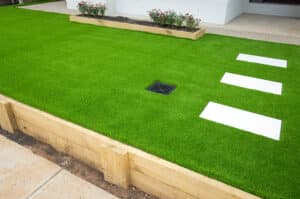
With a plethora of options in the market, making the right choice can be daunting. Here’s a roadmap:
Assess Your Needs: Is it for a backyard, a commercial space, or a sports field? The intended use can guide your choice.
Texture and Feel: If it’s for a residential space, comfort is key. Opt for turfs that offer a soft, natural feel underfoot.
Durability: For high-traffic areas, choose a turf known for its durability.
Consultation: Engage with professionals or visit “synthetic grass near me” stores. Their expertise can guide you to the perfect choice.
Finding Reliable Installers
A flawless installation is key to enjoying the benefits of synthetic turf:
Experience: Opt for installers with a proven track record. Their expertise can ensure the turf is laid perfectly, ensuring longevity.
Reviews: In today’s digital age, reviews are a goldmine of information. Check online reviews or ask for references.
Warranty: A reliable installer will offer a warranty, a testament to their confidence in their workmanship.
DIY vs. Professional Installation
While DIY might seem tempting, it’s essential to weigh the pros and cons:
DIY Pros: Cost savings and the satisfaction of a job done by oneself.
DIY Cons: The potential for errors, lack of specialized tools, and the physical labor involved.
Professional Pros: Expertise, quick installation, and often a warranty on the work.
Professional Cons: The cost involved.
Synthetic turf, with its myriad of benefits, has firmly rooted itself as a preferred choice for many. Whether it’s the allure of a maintenance-free lawn, the environmental benefits, or the sheer aesthetic appeal, the reasons to opt for synthetic grass are compelling. As with any investment, it’s essential to be informed, and hopefully, this guide has shed light on all facets of synthetic turf.
